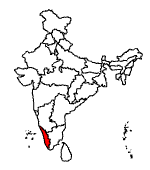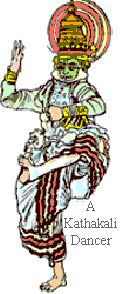
Dimdima
Online Children's Magazine from India

Dimdima
Online Children's Magazine from India
Area : 38,863 sq km.
Population : 3,18,38,619.
Language : Malayalam.
Capital : Thiruvananthapuram, formerly known as Trivandrum is the state capital.
Literacy :
Literacy is high in Kerala with 9 out of 10 children going to school.
Major Towns and Cities :
Kollam (Quilon), Alappuzha (Alleppy), Thrissur (Trichur), Palakkad (Palghat), Kanoor (Cannanore), Kochi (Cochin), Kozhikode (Calicut).(Names in the brackets indicate earlier names)
Rivers & Backwaters :
There are about 44 rivers traversing the state. Of these 41 flow westwards and three eastwards. There are innumerable tributaries.
A unique feature of Kerala are its lagoons. These along with the rivers play a major role in providing economical transportation.
Occupation :
Agriculture is the main occupation of the people. Rice and tapioca are important food crops. Coconut and pepper are the most important cash crops.
Climate :
It is neither too cold in winter, nor too hot in summer. It is monsoon time between June and October, June and
July being the rainiest months. Kerala also receives the northeast monsoons from October. But these are mild showers.
Beaches :
Kerala has some of the finest beaches in India. Some well-known beaches are Shankhumugham, Kovalam, Varkala, Kollam, Kozhikode, Kappad and Kanoor.
Rivers and Backwaters : There are about 44 rivers traversing the state. Of these 41 flow westwards and three eastwards. There are innumerable tributaries.
A unique feature of Kerala are its lagoons. These along with the rivers play a major role in providing economical transportation.
Agriculture is the main occupation of the people. Rice and tapioca are important food crops. Coconut and pepper are the most important cash crops.
Literacy is high in Kerala with 9 out of 10 children going to school.
Kings of what is called the Chera dynasty ruled large parts of Kerala until the A.D. 400's when their power began to decline.
The 'golden age' of Kerala began with the ascendancy of the Kulasekhara dynasty in 825 A.D. and lasted to 1019. During this period art, literature and trade flourished and Malayalam began to develop as a language. A century-long conflict with the Cholas of Tamil Nadu not only destroyed Kerala's prosperity but also its unity as it broke up into warring states. In the ensuing centuries, warrior-statesmen like Marthanda Varma (1729–1758) tried to unite the small principalities and met with varying degrees of success.
When India became free in 1947, there were two princely states in what is now Kerala—Travancore and Cochin.
These two states were brought together to form the Travancore-Cochin State in 1949.
On 1st November 1956 Malabar district was added to Travancore-Cochin and the new state of Kerala came into being.
From Pepper to Colonialism
It was Kerala's pepper that drew European merchants to India from ancient times. The Greeks had found a sea route to India via the Persian Gulf as early as the first century B.C. They made use of the southwest monsoon winds while coming and the northeast monsoon winds while leaving.
The Greeks were followed by the Romans and then the Arabs.
In 1498 Vasco da Gama landed in Kerala after sailing down the west coast of Africa, rounding the Cape of Good Hope and striking out across the Indian Ocean. The new sea route brought European powers to India and then to Asia and the continent came under the yoke of colonialism.
The agricultural year in Kerala begins in April with the Vishu festival. It is celebrated as New Year's Day. Malayalees believe that their fortunes for the year depend on the first things they see on the morning of Vishu. Hence they keep a ‘kani’ comprising items like rice, gold ornaments, coins and a mirror in the pooja room on the previous night and go there to see these things first in the morning.
Towards the middle of August as the monsoon begins to abate, excitement mounts in the boathouses along the backwaters of southern Kerala. There is feverish activity as the famous ‘chundan’ or snakeboats are oiled, repaired and decorated to participate in the ‘Vallamkalli’ or boat race. The most famous races are held in the backwaters of Aranmula, Haripad, Ambalapuzzha and Kuttanad .
Vallamkalli is one of the most spectacular events of Onam, the ten-day harvest festival welcoming Mahabali, the beloved ruler of Kerala. For ten days, children get up early in the morning and then after a bath they wear new clothes and collect flowers. Meanwhile the women of the household clean up a patch on the eastern side of their homes and spread cowdung evenly to make the 'attapu' or the circular flower decoration.
On Thiruvonam day, the most important day of the festival, women and children dance the ‘kummi’ and ‘kaikottikali’ around the ‘attapu’ while singing songs in praise of Mahabali.
Ambalapuzzha on the Alapuzzha-Kollam road, has a famous temple of Sri Krishna, where Kunjan Nambiyar performed his dance-drama, Ottam Thullal for the first time. Also a great attraction for the people who come to this temple is the 'pal-payasam' (kheer) served as 'prasad'.
Though Kerala has several traditional dances, Kathakali is the most famous.



Dimdima is the Sanskrit word for ‘drumbeat’. In olden days, victory in battle was heralded by the beat of drums or any important news to be conveyed to the people used to be accompanied with drumbeats.
Bharatiya Vidya Bhavan
K. M Munshi Marg,
Chowpatty, Mumbai - 400 007
email : editor@dimdima.com
Bharatiya Vidya Bhavan
505, Sane Guruji Marg,
Tardeo, Mumbai - 400 034
email : promo@dimdima.com
Dimdima.com, the Children's Website of Bharatiya Vidya Bhavan launched in 2000 and came out with a Printed version of Dimdima Magazine in 2004. At present the Printed Version have more than 35,000 subscribers from India and Abroad.